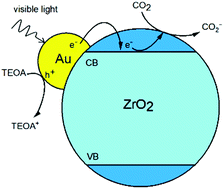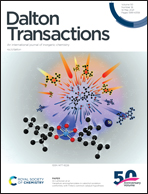Plasmon-assisted photocatalytic CO2 reduction on Au decorated ZrO2 catalysts†
Abstract
ZrO2 is one of the most stable metal oxides which is applicable to various chemical reactions in harsh environments. However, the photocatalytic performance of ZrO2 is relatively poor due to the negligible use of the solar spectrum caused by the wide bandgap (Eg = 5.3 eV). Here, we report plasmon enhanced Au nanoparticles decorated onto ZrO2 through a facile tannic acid-reduction method. The Au/ZrO2 heterojunctions exhibited efficient and stable photocatalytic activity of reducing CO2 into main CO and CH4, at the rates of 25.6 μmol g−1 h−1 and 5.1 μmol g−1 h−1 at most, respectively, approximately 6-fold enhanced compared to the pristine ZrO2, under simulated solar light. The reduction rates could also be improved over 10-fold under visible light when Au nanoparticles were loaded onto ZrO2. UV-Vis diffuse reflectance spectra confirmed the enhanced visible-light absorption of Au/ZrO2 caused by localized surface plasmon resonance (LSPR). Electrochemical impedance spectra (EIS) and photocurrent tests proved the more efficient charge transport and electron–hole separation of Au/ZrO2 heterojunctions. This study demonstrates an effective strategy of LSPR effects to improve the photocatalytic performances of semiconductors.



 Please wait while we load your content...
Please wait while we load your content...